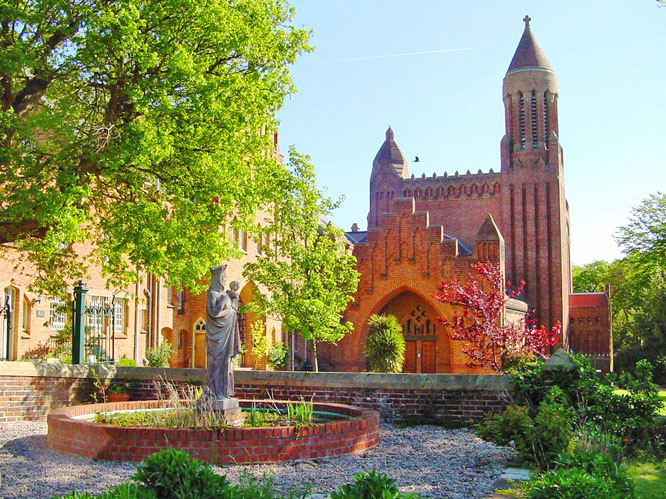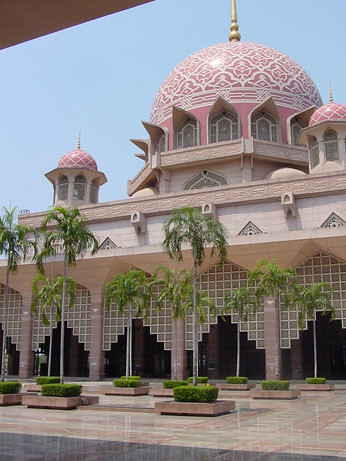The Form of true Sacred Architecture

This is the beautiful abbey church of Quarr on the Isle of Wight. It is a Benedictine foundation, completed in 1914 and designed by Dom Bellot, OSB. Although a modern church building it is beautiful, austere and is immediately identifiable as a church. The bell tower and the general upward thrust of the building speaks of a straining towards heaven and God that is the characteristic of the people who worship within.

In a similar way, the ancient cathedral of Durham, once a great Benedictine house also has this sense of leading the eye (and one's soul) to heaven and yet it has a certain austerity of its own. It dominates the landscape, standing firm as a witness to the Church and the Gospel she proclaims. Although almost 900 years separate the completion of both these buildings, they both embody the same spirit of austerity, prayer and majesty. As such, they are recognised as sacred buildings, churches wherein God is worshiped and praised.
These characteristics of sacred architecture is not exclusive to Christian churches. Indeed, today as I was travelling through eastern Singapore, I noticed how in this multi-racial, multi-cultural and multi-religious City-State, religious buildings are often grouped together; it's not unusual to see a church, a mosque, a Buddhist temple and a Hindu temple side by side! A wonderful example of inter-religious harmony.
However, I also noticed how each of these structures had a very distinct style that instantly enabled one to identify each as the respective houses of worship for Christians, Muslims, Buddhists or Hindus. Moreover, they all had a certain style, a continuity with history and their historical culture that set them apart from secular and civic buildings. As such, they were rooted in time and space.
This factor is crucial for human beings who are called to use these buildings so intimately for that most spiritual of purposes - worship and prayer. As people rooted in time and space, we have a deep rooted attachment to the traditional forms of such structures. To eradicate or radically alter them is to alienate us at a profound level, to disturb the very centres where we are moved to prayer. For a sacred building, a church is more than just a "worship space". If that were all we need, a grove of trees would equally suffice! A church is much more than that; it is a visible expression of the Christian faith, a witness to the world of the presence of Christ in our midst. As Pope Benedict XVI said:
"As a consquence, Christians are now deriving pleasure from making faith visible, for constructing its symbol in the world of matter. The other basic idea is connected to this: the idea of glorification, the attempt to turn the earth into praise, right down to the stones themselves, and thus to anticipate the world to come. The buildings in which faith is expressed are, as it were, a visualized hope and a confident statement of what can come to be, projected into the present."

When I look at those religious buildings in Singapore, I know immediately which one is which. Were I to seek a Muslim house of worship, I would enter the mosque. The photo on the left of the Purajaya Mosque in Malaysia is instantly recognizable as a mosque. It's geometric shapes and patterns, the dome, the small minarets in the four corners are all hallmarks of the Islamic house of worship.
The same should be true of our churches. There should be certain hallmarks that set them out as Christian house of worship, apart from the cross... and a number of modern churches don't even have these! Seen from a distance, as with Durham Cathedral or Quarr Abbey, the church building should evoke God, be recognised as a church and draw those who seek Jesus Christ. As a true and faithful witness to the presence of Christ, it must evangelise, so that those seeking Him know where to go.
Travelling in Germany or England, I often look for a church to worship or pray in and I can see it from afar by it's tower or spire. It calls to me and invites me to enter and pray. By its exterior and interior beauty it moves me to worship, strengthens my faith and gives me hope in the Resurrection and the Life of the world to come.
When a church building no longer does this, when the symbol is diminished, it suggests that the theology, the reality it once expressed is also diminished or no longer believed in with such vigour... Many modern church buildings look like auditoria, concert halls, barns, fire stations even! Is it any wonder then that they are treated as such, the people of God, gathered within as if for a performance - not truly active participants but spectators, an audience?! The Liturgy becomes akin to a show, striving for relevance and entertainment value... and the people within envisage their faith purely in human and worldly terms, forgetting the fact that we were made for eternal beatitude in heaven. The symbol represents the reality.
This is not to ignore the essential fact that the spiritual stones of the Church are first and foremost her members. The baptised by their prayers, virtues and holiness make up a splendid temple for God. Of course, it is the people that matter most and not our buildings. I do not deny this nor would I suggest otherwise. But Pope Benedict reminds us that "the beauty of the cathedral does not stand in opposition to the theology of the cross, but is its fruit." Without this beauty, the world would be a "desert of utility in which the heart would probably stop beating." For many Christians, faced with new utilitarian or unattractive churches and Liturgy, that spiritual heart has suffered a stroke! The building, the form of the traditional church, so dear to them and so ingrained in the Christian psyche, that moves them to prayer and heaven has been obliterated. As such, one is suddenly bereft of beauty and a powerful aid to prayer - one cannot pray, faced with ugliness, strange alien forms and the minimalism of modernity.
Faced with a church building that witnesses not to Christ and His Church by its form (as we have seen in the examples above) but to the secular world, is it any surprise that we too become focussed on the cares and pursuits of this world? And what evangelistic purpose can a church without a cross, disguised as a barn or a civic hall serve? None. The sad fact is that these buildings embody modernist ideals, built and designed by modernists for a post-modern Church and one day, my generation will have to spend more money to un-do this travesty!
But let me not persuade you with words but with the eloquence of pictures, of the very image of the buildings themselves... and ask yourself as you view them, as if you walked past them: What building is that? Would one immediately say: a church!? I know that in the cases of Durham and Quarr, one would say so but am less confident in the cases below:

For more on this topic and the hallmarks of traditional church architecture, to compare and contrast good and bad architecture, to view the work of contemporary architects designing true sacred buildings and more, visit the excellent Church Architecture site.








2 Comments:
Yeah, I know. Some of it's hideous, and the theology (?!) behind it is even worse!
http://quarr-abbey.blogspot.com/
Post a Comment
<< Home